Chapter 13: Infusion Therapy – Flashcards
Unlock all answers in this set
Unlock answersquestion
the delivery of meds in solution and fluids by parenteralroute through a wide variety of catheter types and locations using multiple procedures
answer
infusion therapy
question
-maintain fluid balance or correct fluid imbalance -maintain electrolyte or acid base balance or correct electrolyte or acid base imbalance -administer meds -replace blood or blood products
answer
common reasons for IV therapy
question
between 270-300 mOsm/L (isotonic)
answer
normal serum osmolarity for adults is
question
fluids greater than 300 mOsm/L
answer
hypertonic
question
fluids less than 270 mOsm/L
answer
hypotonic
question
solution that is infused into the body
answer
infusate
question
the inflammation of a vein caused by mechanica, chemical, or bacterial irritation
answer
phlebitis
question
when IV solution leaks into the tissues around the vein
answer
infiltration
question
blood clot in the vein
answer
thrombosis
question
chemicals that damage body tissues on direct contact
answer
vesicants
question
results in severe tissue integrity impairment as manifested by blistering, tissue sloughing, or necrosis from infiltration into the surrounding tissues
answer
extravasation
question
an unexpected occurence involving serious physical or psychological injury or the risk thereof and requiring an intense analysis of the contributing factors and corrective action
answer
sentinel event
question
IV drugs provide a rapid therapeutic effect but can lead to immediate serious reactions
answer
adverse drug events
question
-specific type of fluid -rate of administration -drugs and the specific dose
answer
prescription for infusion fluids should include
question
-drug name -specific dose or route -frequency of administration -time of administration -length of infusion time -purpose
answer
prescription for drugs should include
question
infusion catheter; VAD; a plastic tube placed in a blood vessel to deliver fluids and meds; seven types: -short peripheral catheters -midline -peripherally inserted central catheters (PICC) -nontunneled percutaneous central venous catheters (CVCs) -tunneled catheters -implanted ports -hemodialysis catheters
answer
vascular access device
question
short infusion catheters are the most commonly used vascular access devices (VADs); usually placed in the veins of the arm

answer
peripheral IV therapy
question
composed of a plastic cannula built around a sharp stylet extending slightly beyond the cannula
answer
short peripheral catheters
question
shortest, smallest (3/4in length); not ideal for viscous infusions, expect blood transfusion to take longer, preferred for infants and small children. approx 24mL/min (1440 mL/hr)
answer
24-26 gauge
question
adequate for most therapies, blood can infuse without damage. 39mL/min (2280 mL/hr)
answer
22 gauge
question
(1-1 1/4 in leangth) adequate for all therapies, most providers of anesthesie perfer not to use smaller size than this for surgery cases. 65 mL/min (3900 mL/hr)
answer
20 gauge
question
preferred size for surgery, vein needs to be large enough to accomodate the catheter. 110mL/min (6600 mL/hr)
answer
18 gauge
question
for trauma and surgical patients requiring rapid fluid resuscitation; needs to be in a vein that can accomodate that
answer
14-16 gauge
question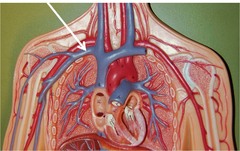

answer
subclavian vein
question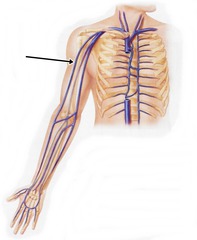

answer
cephalic vein
question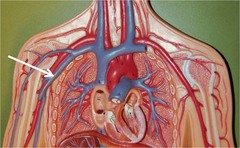

answer
axillary vein
question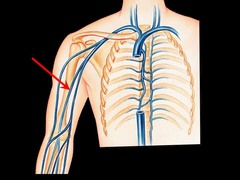

answer
brachial vein
question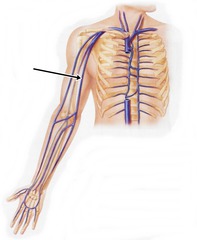

answer
basilic vein
question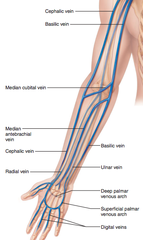

answer
median cephalic vein
question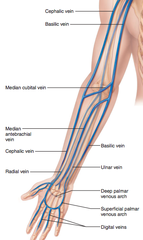

answer
median basilic vein
question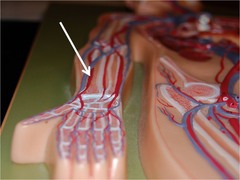

answer
radial vein
question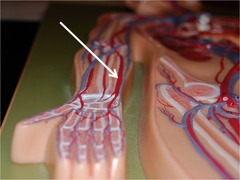

answer
ulnar vein
question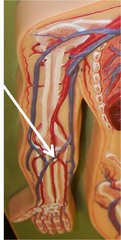

answer
median vein
question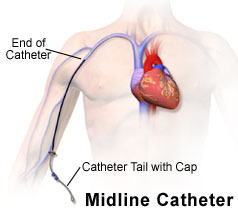
anywhere from 3-8in long, double or single lumen, inserted through upper arm veins

answer
midline catheters
question
midline catheters should not be used for these; drugs that cause severe tissue damage if they escape into subcutaneous tissue (extravasation)
answer
vesicant medications
question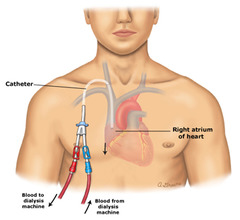
the VAD is placed in the central circulaiton, specifically within the superior vena cava near its junction with the right atriu, also called the caval-atrial junction

answer
central IV therapy
question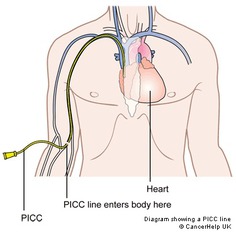
PICC; a long catheter inserted through a vein of the antecubital fossa, or the middle of the upper arm; lengths range from 18-29in

answer
peripherally inserted central catheter
question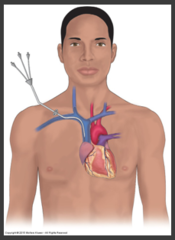
CVCs, inserted by a physician, trained PA, or NP through the subclavian vein in the upper chest or the internal jugular veins in the neck using sterile technique

answer
nontunneled percutaneous central venous catheters
question
VADs that have a portion of the catheter lying in a subcutaneous tunnel, seperating the points where the catheter enters the vein from where it exits the skin
answer
tunneled cental venous catheters
question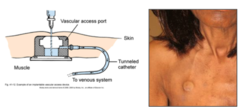
very different from other central vascular access devices, chosen for patients who are expected to require IV therapy for more than a year

answer
implanted ports
question
"piggybacks", attached to the primary set at a Y-junction site and is used to deliver intermittent meds
answer
secondary administration set
question
an electronic or battery powered piston to push the plunger continuously at a selected milliliter per hour rate; limited to small volume continuous or intermittent infusions and depnds on the syringe size
answer
syringe pumps
question
generally used for home care patients and allow them to return to their usual activities while receiving infusion therapy
answer
ambulatory pumps
question
infusion pumps with dosage calculation software; promotoed to reduce adverse drug events
answer
smart pumps
question
-date/time of insert -name of nurse who inserted it -vein used -type of VAD -number of attempts and locations -patient response to insertion -type of dressing applied -type of securment device is used -special barrier precautions used -patient and family education provided
answer
when inserting a venous catheter, remember to document
question
used for a variety of drug infusions; administration of pain meds and insulin therapies
answer
subcutaneous infusion therapy
question
"clysis"; the slow infusion of isotonic fluids into the patient's subcutaneous tissue
answer
hypodermoclysis
question
allows access to the rich vascular network in the red marrow of bones
answer
intraosseous therapy
question
condition in which increased tissue pressure in a confied anatomic space causes decreased perfusion (blood flow to the area)
answer
compartment syndrome
question
monitor various hemodynamic pressures continuously and to infuse chemotherapy agents or fibrinolytics
answer
intra-arterial infusion therapy
question
the administration of chemotherapy agents into the peritoneal cavity
answer
intraperitoneal infusion therapy
question
space between the dura mater and vertebrae and the subarachnoid space
answer
epidural
question
medications are infused into the subarachnoid space and directly into the cerebral spinal fluid allowing reduced doses
answer
intrathecal



